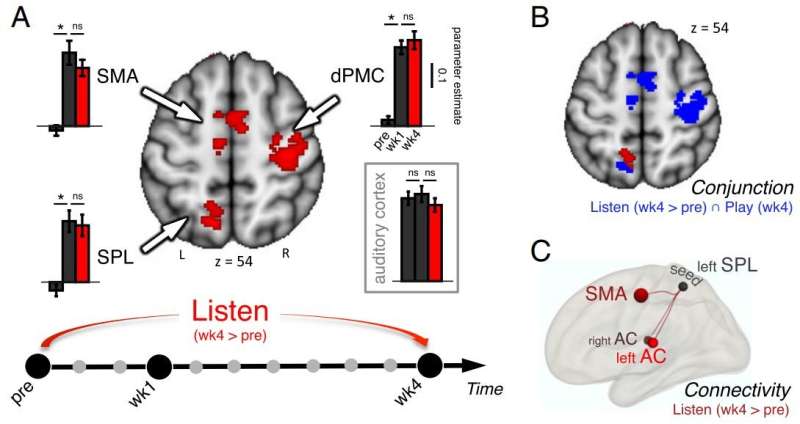June 15, 2018 report
Observing brain plasticity during cello training

Music acquisition provides an excellent model of neural plasticity, and has become a hot research subject in neurology. Music performance provides an unmatched array of neural complexities revealing how neural networks are recruited, and how these dynamics vary between individuals. Observing the brain activity of performing musicians via fMRI has yielded insights into the coactivated auditory and motor neural systems and opened pathways to deeper understanding of neural plasticity.
According to previous studies, co-activation of the auditory and motor systems occurs in both auditory-only and motor-only tasks. Researchers have largely concluded that auditory-motor transformations occur in the dorsal auditory-to-motor cortical pathway; this circuit is highly recruited while playing a musical instrument.
A new longitudinal study, published in the Proceedings of the National Academy of Sciences, goes beyond previous work by observing the recruitment of brain networks in cello training. While other studies focused on the auditory-motor systems of keyboard players, this study presented a unique opportunity to observe neural plasticity during training in asymmetrical manual dexterity, as one hand is controlling shifts in position and finger pressure on the strings while the other hand manipulates the bow. The researchers designed a special MRI-compatible cello for the study and scanned 13 volunteers at varying levels of cello training.
String players in general are engaged with an unusually complex series of auditory-motor interactions: Pitch can be affected by multiple actions; different fingers on different strings can produce the same notes. By contrast, with piano, there is a one-to-one correspondence between motor actions and notes produced. "Therefore, a critical component of string instrument learning is developing the ability to perform rapid online pitch corrections, i.e., instantaneous sensorimotor adjustments, to play a tune," the authors write.
The study was designed to capture changes in brain activity patterns and how they related to observable behavioral changes associated with cello training. The researchers report three primary findings: (1) Evidence of functional reorganization in the auditory-motor cortex; (2) Better performers have optimized recruitment of regions associated with auditory encoding and motor control; (3) Levels of activity in the region anterior to the supplementary motor area during pre-training listening exercises are predictors of musical proficiency. In other words, the researchers found that they could predict via MRI during listening sessions which musicians would have the most aptitude for the cello.
They conclude that there are dissociated brain networks that are modified during training, versus those modified during performance, versus those that serve as predictors of aptitude. These circuits have different perceptual, cognitive and motor functions depending on the activity. The researchers believe their results will contribute to future research on sensory-motor learning with applications in pedagogy and physical rehabilitation.
More information: Neural network retuning and neural predictors of learning success associated with cello training. Proceedings of the National Academy of Sciences, doi.org/10.1073/pnas.1721414115
Abstract
The auditory and motor neural systems are closely intertwined, enabling people to carry out tasks such as playing a musical instrument whose mapping between action and sound is extremely sophisticated. While the dorsal auditory stream has been shown to mediate these audio–motor transformations, little is known about how such mapping emerges with training. Here, we use longitudinal training on a cello as a model for brain plasticity during the acquisition of specific complex skills, including continuous and many-to-one audio–motor mapping, and we investigate individual differences in learning. We trained participants with no musical background to play on a specially designed MRI-compatible cello and scanned them before and after 1 and 4 wk of training. Activation of the auditory-to-motor dorsal cortical stream emerged rapidly during the training and was similarly activated during passive listening and cello performance of trained melodies. This network activation was independent of performance accuracy and therefore appears to be a prerequisite of music playing. In contrast, greater recruitment of regions involved in auditory encoding and motor control over the training was related to better musical proficiency. Additionally, pre-supplementary motor area activity and its connectivity with the auditory cortex during passive listening before training was predictive of final training success, revealing the integrative function of this network in auditory–motor information processing. Together, these results clarify the critical role of the dorsal stream and its interaction with auditory areas in complex audio–motor learning.
© 2018 Medical Xpress

















